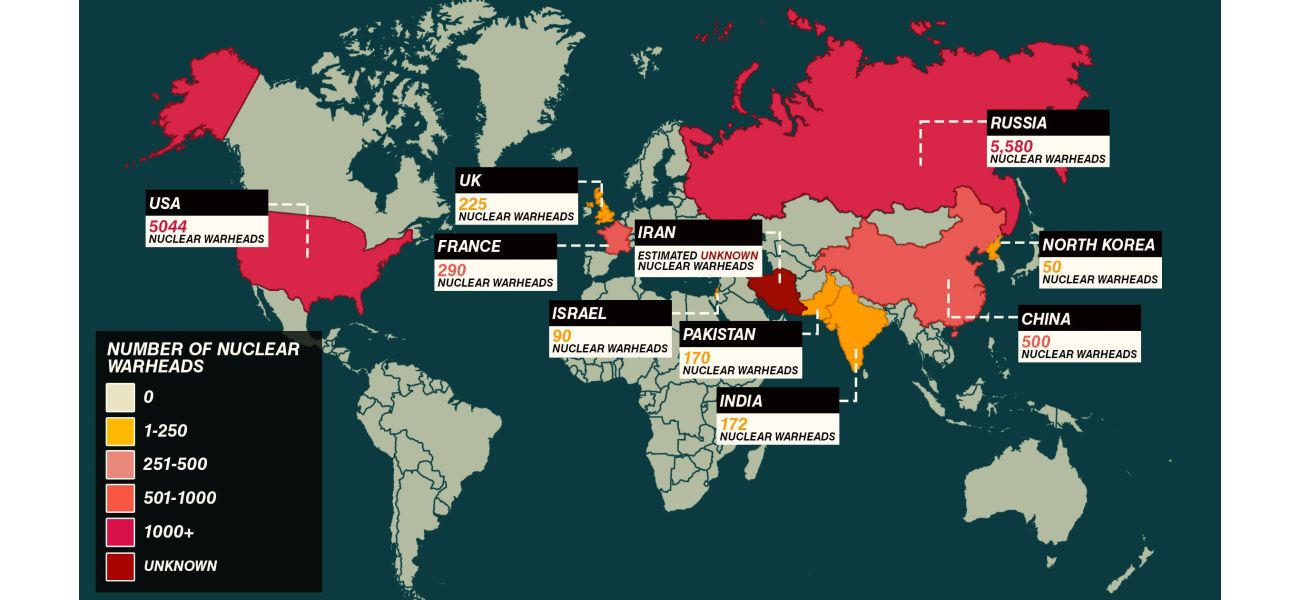A map displays countries with the most nuclear weapons following Putin's recent threat.
World War III feels more imminent than ever before, marking a significant shift since the Cold War.
September 26th 2024.

The map I'm looking at right now is quite concerning. It's showing that Russian President Vladimir Putin has once again issued a nuclear threat towards the West. In short, Russia is willing to use nuclear weapons if they are attacked by any other country. This news comes at a time when Ukraine has been planning to launch strikes into Russian territory with the help of Western missiles. Their goal is to gain an advantage in the ongoing war between the two nations. However, the UK and US have refused to allow Ukraine to use their weapons, and Putin's latest threat only adds to their hesitation.
Putin has made it clear that any country supporting an attack on Russia will be seen as a participant in the aggression. This is essentially a warning to Western nations who may be considering whether or not to allow Ukraine to use their long-range weapons. It's worth noting that Russia currently has the largest nuclear stockpile in the world, with a whopping 5,580 warheads. This makes the threat even more alarming.
But let's take a step back and look at the bigger picture. Which countries actually possess nuclear weapons and how many do they have? According to the Agency, there are nine countries that have officially declared their possession of nuclear arms. One of them is North Korea, with an estimated 50 warheads and the potential to double that number if desired.
Moving on to Israel, it's estimated that they have 90 nuclear warheads and the capability to deliver them by air, through cruise missiles fired from submarines, and the Jericho line of ballistic missiles. However, Israel has never publicly acknowledged their nuclear program and has kept it a well-kept secret. This makes it difficult to determine the full extent of their nuclear capabilities.
Next up is India, with an estimated 172 warheads. They have been steadily increasing their stockpile in recent years, with the intention of using them as a means of self-defense against neighboring countries like Pakistan and China. Speaking of Pakistan, they have a similar nuclear capacity as India, with an estimated 170 warheads. This is mainly to offset India's military strength. Pakistan started developing nuclear weapons after their war with India in 1971, and their program has only grown since then.
Now let's take a look at the Western nations. The United Kingdom has 225 warheads, making them the fifth-highest nuclear power in the world. Their nuclear deterrent is located in HM Naval Base Clyde in Scotland, while the submarines that would fire the weapons are stationed at Faslane.
France has the fourth-largest declared stockpile of nuclear weapons, with an estimated 290 warheads. Despite being a friendly nation with little conflict, they still maintain a large number of nuclear weapons, all of which are ready to be fired at any time. However, they have reduced their arsenal by 50% since the Cold War.
China comes in at number three, with an estimated 500 warheads. This may not come as a surprise, considering their status as one of the world's superpowers. The Pentagon predicts that this number will rise to 1,000 by 2030. And then there's the United States, with a staggering 5,044 warheads. This may seem like a lot, but at one point, they had over 32,000 in their arsenal. Currently, they have around 2,000 deployed and ready to be fired if needed.
Finally, we have Russia, with the largest declared number of warheads at 5,580. It's no surprise that they hold this title, as they have always strived to have a nuclear arsenal comparable to or greater than that of the United States. More than 1,600 of their warheads are ready to be fired at any time, making them a formidable nuclear power.
Lastly, we have Iran, who has been transparent about their nuclear program but claims to have no warheads and no plans to develop them. However, their production of fissile material has increased significantly since the US pulled out of a nuclear non-proliferation treaty in 2018. They currently have enough enriched uranium to make several nuclear bombs, but their lack of ICBMs makes it difficult for them to launch the weapons.
In conclusion, the world is still heavily armed with nuclear weapons, and the threat of their use is always looming. The map may be concerning, but it's important to understand the capabilities and intentions of each country possessing them. Only time will tell how these weapons will shape the future of our world.
Putin has made it clear that any country supporting an attack on Russia will be seen as a participant in the aggression. This is essentially a warning to Western nations who may be considering whether or not to allow Ukraine to use their long-range weapons. It's worth noting that Russia currently has the largest nuclear stockpile in the world, with a whopping 5,580 warheads. This makes the threat even more alarming.
But let's take a step back and look at the bigger picture. Which countries actually possess nuclear weapons and how many do they have? According to the Agency, there are nine countries that have officially declared their possession of nuclear arms. One of them is North Korea, with an estimated 50 warheads and the potential to double that number if desired.
Moving on to Israel, it's estimated that they have 90 nuclear warheads and the capability to deliver them by air, through cruise missiles fired from submarines, and the Jericho line of ballistic missiles. However, Israel has never publicly acknowledged their nuclear program and has kept it a well-kept secret. This makes it difficult to determine the full extent of their nuclear capabilities.
Next up is India, with an estimated 172 warheads. They have been steadily increasing their stockpile in recent years, with the intention of using them as a means of self-defense against neighboring countries like Pakistan and China. Speaking of Pakistan, they have a similar nuclear capacity as India, with an estimated 170 warheads. This is mainly to offset India's military strength. Pakistan started developing nuclear weapons after their war with India in 1971, and their program has only grown since then.
Now let's take a look at the Western nations. The United Kingdom has 225 warheads, making them the fifth-highest nuclear power in the world. Their nuclear deterrent is located in HM Naval Base Clyde in Scotland, while the submarines that would fire the weapons are stationed at Faslane.
France has the fourth-largest declared stockpile of nuclear weapons, with an estimated 290 warheads. Despite being a friendly nation with little conflict, they still maintain a large number of nuclear weapons, all of which are ready to be fired at any time. However, they have reduced their arsenal by 50% since the Cold War.
China comes in at number three, with an estimated 500 warheads. This may not come as a surprise, considering their status as one of the world's superpowers. The Pentagon predicts that this number will rise to 1,000 by 2030. And then there's the United States, with a staggering 5,044 warheads. This may seem like a lot, but at one point, they had over 32,000 in their arsenal. Currently, they have around 2,000 deployed and ready to be fired if needed.
Finally, we have Russia, with the largest declared number of warheads at 5,580. It's no surprise that they hold this title, as they have always strived to have a nuclear arsenal comparable to or greater than that of the United States. More than 1,600 of their warheads are ready to be fired at any time, making them a formidable nuclear power.
Lastly, we have Iran, who has been transparent about their nuclear program but claims to have no warheads and no plans to develop them. However, their production of fissile material has increased significantly since the US pulled out of a nuclear non-proliferation treaty in 2018. They currently have enough enriched uranium to make several nuclear bombs, but their lack of ICBMs makes it difficult for them to launch the weapons.
In conclusion, the world is still heavily armed with nuclear weapons, and the threat of their use is always looming. The map may be concerning, but it's important to understand the capabilities and intentions of each country possessing them. Only time will tell how these weapons will shape the future of our world.
[This article has been trending online recently and has been generated with AI. Your feed is customized.]
[Generative AI is experimental.]
0
0
Submit Comment





